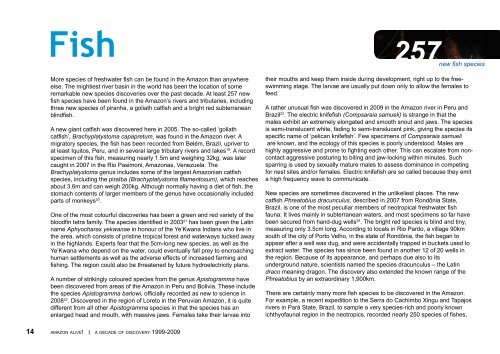Amazon Alive: A Decade of Discoveries 1999-2009 - WWF
Amazon Alive: A Decade of Discoveries 1999-2009 - WWF
Amazon Alive: A Decade of Discoveries 1999-2009 - WWF
Create successful ePaper yourself
Turn your PDF publications into a flip-book with our unique Google optimized e-Paper software.
Fish<br />
257new fish species<br />
More species <strong>of</strong> freshwater fish can be found in the <strong>Amazon</strong> than anywhere<br />
else. The mightiest river basin in the world has been the location <strong>of</strong> some<br />
remarkable new species discoveries over the past decade. At least 257 new<br />
fish species have been found in the <strong>Amazon</strong>’s rivers and tributaries, including<br />
three new species <strong>of</strong> piranha, a goliath catfish and a bright red subterranean<br />
blindfish.<br />
A new giant catfish was discovered here in 2005. The so-called ‘goliath<br />
catfish’, Brachyplatystoma capapretum, was found in the <strong>Amazon</strong> river. A<br />
migratory species, the fish has been recorded from Belém, Brazil, upriver to<br />
at least Iquitos, Peru, and in several large tributary rivers and lakes 19 . A record<br />
specimen <strong>of</strong> this fish, measuring nearly 1.5m and weighing 32kg, was later<br />
caught in 2007 in the Rio Pasimoni, <strong>Amazon</strong>as, Venezuela. The<br />
Brachyplatystoma genus includes some <strong>of</strong> the largest <strong>Amazon</strong>ian catfish<br />
species, including the piraíba (Brachyplatystoma filamentosum), which reaches<br />
about 3.6m and can weigh 200kg. Although normally having a diet <strong>of</strong> fish, the<br />
stomach contents <strong>of</strong> larger members <strong>of</strong> the genus have occasionally included<br />
parts <strong>of</strong> monkeys 20 .<br />
One <strong>of</strong> the most colourful discoveries has been a green and red variety <strong>of</strong> the<br />
bloodfin tetra family. The species identified in 2003 21 has been given the Latin<br />
name Aphyocharax yekwanae in honour <strong>of</strong> the Ye’Kwana Indians who live in<br />
the area, which consists <strong>of</strong> pristine tropical forest and waterways tucked away<br />
in the highlands. Experts fear that the 5cm-long new species, as well as the<br />
Ye’Kwana who depend on the water, could eventually fall prey to encroaching<br />
human settlements as well as the adverse effects <strong>of</strong> increased farming and<br />
fishing. The region could also be threatened by future hydroelectricity plans.<br />
A number <strong>of</strong> strikingly coloured species from the genus Apistogramma have<br />
been discovered from areas <strong>of</strong> the <strong>Amazon</strong> in Peru and Bolivia. These include<br />
the species Apistogramma barlowi, <strong>of</strong>ficially recorded as new to science in<br />
2008 22 . Discovered in the region <strong>of</strong> Loreto in the Peruvian <strong>Amazon</strong>, it is quite<br />
different from all other Apistogramma species in that the species has an<br />
enlarged head and mouth, with massive jaws. Females take their larvae into<br />
their mouths and keep them inside during development, right up to the freeswimming<br />
stage. The larvae are usually put down only to allow the females to<br />
feed.<br />
A rather unusual fish was discovered in <strong>2009</strong> in the <strong>Amazon</strong> river in Peru and<br />
Brazil 23 . The electric knifefish (Compsaraia samueli) is strange in that the<br />
males exhibit an extremely elongated and smooth snout and jaws. The species<br />
is semi-translucent white, fading to semi-translucent pink, giving the species its<br />
specific name <strong>of</strong> ‘pelican knifefish’. Few specimens <strong>of</strong> Compsaraia samueli<br />
are known, and the ecology <strong>of</strong> this species is poorly understood. Males are<br />
highly aggressive and prone to fighting each other. This can escalate from noncontact<br />
aggressive posturing to biting and jaw-locking within minutes. Such<br />
sparring is used by sexually mature males to assess dominance in competing<br />
for nest sites and/or females. Electric knifefish are so called because they emit<br />
a high frequency wave to communicate.<br />
New species are sometimes discovered in the unlikeliest places. The new<br />
catfish Phreatobius dracunculus, described in 2007 from Rondônia State,<br />
Brazil, is one <strong>of</strong> the most peculiar members <strong>of</strong> neotropical freshwater fish<br />
fauna. It lives mainly in subterranean waters, and most specimens so far have<br />
been secured from hand-dug wells 24 . The bright red species is blind and tiny,<br />
measuring only 3.5cm long. According to locals in Rio Pardo, a village 90km<br />
south <strong>of</strong> the city <strong>of</strong> Porto Velho, in the state <strong>of</strong> Rondônia, the fish began to<br />
appear after a well was dug, and were accidentally trapped in buckets used to<br />
extract water. The species has since been found in another 12 <strong>of</strong> 20 wells in<br />
the region. Because <strong>of</strong> its appearance, and perhaps due also to its<br />
underground nature, scientists named the species dracunculus – the Latin<br />
draco meaning dragon. The discovery also extended the known range <strong>of</strong> the<br />
Phreatobius by an extraordinary 1,900km.<br />
There are certainly many more fish species to be discovered in the <strong>Amazon</strong>.<br />
For example, a recent expedition to the Serra do Cachimbo Xingu and Tapajos<br />
rivers in Pará State, Brazil, to sample a very species-rich and poorly known<br />
ichthy<strong>of</strong>aunal region in the neotropics, recorded nearly 250 species <strong>of</strong> fishes,<br />
14 amazon alive! I a decade <strong>of</strong> discovery <strong>1999</strong>-<strong>2009</strong>

















